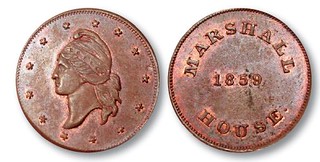
PREV ARTICLE
NEXT ARTICLE
FULL ISSUE
PREV FULL ISSUE
THE DISCOVERY OF THE ORIGINAL CONFEDERATE CENT
In the January 2016 issue of The Numismatist (the official publication of the American Numismatic Association), P. Scott Rubin
published an article on the discovery of the original Confederate Cent. Here's an excerpt. I added an image of the Confederate Cent
from an earlier E-Sylum article. -Editor
The coin’s obverse image of Liberty (sometimes called “French Liberty”) is unlike that on any cent circulated by the United States; however, it is identical to the image used by die-sinker Robert Lovett Jr. (1824-79) to create trade tokens he made for himself and coin dealer William Idler (1808-1901). The obverse also bears the legend CONFEDERATE STATES OF AMERICA. The reverse displays a wreath of corn, cotton and tobacco, with two barrels and a cotton bale along the bottom. Within the wreath is the denomination, 1 CENT. The letter “L” on the bale identifies Lovett as the designer. The coin was struck in “medal turn” (side-to-side rotation) as opposed to the standard “coin turn” (top-to-bottom rotation). As far as we know, the coins’ connection with the Confederate government is undocumented. It has been speculated that Lovett, who had done work for Bailey & Company of Philadelphia, had been asked to create dies for a proposed cent coinage for the Confederacy through the Pennsylvania firm. Again, no documentation exists to support this assumption. I believe one of two events prompted Lovett to produce the Confederate cent: either he was contacted by a Southern sympathizer, or he thought he could entice the Confederate government to purchase dies for a cent coinage. 
Copper token produced in 1859 by Robert Lovett Jr. for the Marshall House hotel in Alexandria, Virginia The Discovery
Two sales in particular—Haseltine’s auction on January 13-15, 1874 (Lot 665) and S.H. & H. Chapman’s auction on November 27-28, 1891 (Lot 823)—reveal how the coin became available to the collecting public and who was involved. The catalog for the latter describes the true discovery of the Confederate cent and indicates Haseltine had nothing to do with it. The numismatic world had all but forgotten Haseltine’s original story until I presented an exhibit at the American Numismatic Association’s 1992 convention in Orlando, Florida, entitled “Auction Catalogues as Sources of Information.” Among the items I displayed was a copy of Haseltine’s 1874 catalog, along with his description of the Confederate cent: CONFEDERATE CENT
[The dies for the above piece were made by Mr. Lovett, of Philadelphia, In 1861. Mr. Lovett says that they were ordered in 1861, for the South, and that the dies were delivered. Previous to delivering the dies, he struck twelve pieces, but showed them to no one and kept the matter quiet, fearing that he might be arrested if it were known. It was not until about six months since Mr. Lovett parted with all he had (either ten or twelve) to Dr. E. Maris, of Philadelphia, from whom this one was obtained. Although it is evident that the Southern Confederacy did not adopt this piece, still it will always be considered interesting and valuable as the only coinage designed for the Southern Confederacy, and will no doubt bring a high price. I have been somewhat particular in giving the facts about this piece, as there are persons who always sneer at and doubt anything new and interesting that is discovered by other than themselves. J.W.H.] For more information on the American Numismatic Association, see:
To read the earlier E-Sylum article, see:
THE BOOK BAZARREWayne Homren, Editor The Numismatic Bibliomania Society is a non-profit organization promoting numismatic literature. See our web site at coinbooks.org. To submit items for publication in The E-Sylum, write to the Editor at this address: whomren@gmail.com To subscribe go to: https://my.binhost.com/lists/listinfo/esylum All Rights Reserved. NBS Home Page Contact the NBS webmaster 
|
